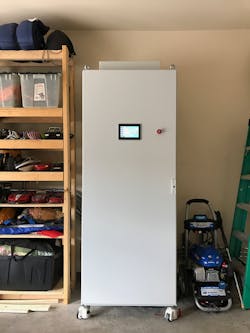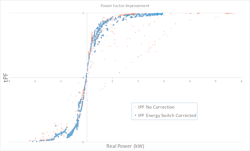The Energy Switch—A Residential Microgrid
As part of DOE-FOA-0001225, a DOE-funded program in conjunction with Concurrent Design, Pecan Street developed a residential microgrid called The Energy Switch. The program was a fast-paced, one-year development that included a two-month demonstration and ended with NREL doing a third-party validation of performance.
Several years ago, power quality monitoring equipment was installed in several homes with solar PV in Pecan Street’s Austin testbed. The results were not necessarily surprising, but they did point to issues that the previous generation of legacy inverters or the current generation of Rule 21-compliant smart inverters do not address.
One of those issues was the resultant power factor at the service entrance of a modern residential structure. The solar often replaces the real power load of the structure, leaving the utility to support the reactive power portion of the load.
In many of the engineering texts for power distribution, the classical assumption is that a residential structure is a significantly high-quality load, typically a power factor of .95. Unfortunately, that is no longer the case; structures without solar are commonly measured at total power factors of below .8, sometimes falling below .7. Making matters more complicated for system planners, total power factor is comprised of two components, distortion and displacement.
Historically when homes fall below a power factor of .95-.97, the power factor has been mostly caused by current displacement and has been lagging because of the motors for HVAC systems and refrigerators. Modern home loads do not show this behaviour: the switch-mode power supplies for CFL/LED lighting, variable speed drives, set-top boxes, phone chargers and computers rarely seem to be power factor-corrected well in an effort to keep costs low. Individual set-top boxes, washing machines and high-efficiency lighting have been measured at a power factor under .6. More complicated yet is the fundamental displacement current in these devices is often leading. Houses have been measured changing from leading to lagging loads 70 times a day. Add to that the more well-known issues of matching the generation to the load profile, voltage control, congestion management and demand response needs, and Pecan Street thought that there was an opportunity for a very smart energy storage system.
The Energy Switch is a complex system that includes:
- 10-kWh energy storage
- 9.5-kW peak power
- 24 circuits of load control/ monitoring
- API addressable
- Capable of supporting ac or dc solar connection
- Maintains operation of ac-coupled solar during a grid outage
- Accepts grid, generator and ac solar input energy
- Can discharge battery to provide real/ reactive power grid support
- Can set limits of both generation and load demand power
- Can support black start through multiple behaviors, including immediate reconnect and generation, or delayed reconnection maintaining residential power throughout the blackout.
The end-user has access to five operating modes:
- Maximize Self Consumption – keeps as much local generation as possible, minimizing reverse flows to the grid
- Maximize Grid Support – the system monitors grid voltage and provide power or load as necessary using a voltage set point as the trigger for generation/load
- Grid Outage Without Secondary Generation – the system shuts off all but the critical load circuits to maximize battery life during an outage. Excess solar production is routed to the batteries or curtailed if necessary
- Grid Outage With Secondary Generation – the system signals a generator to start and reconnect a portion or all of the circuits disconnected in Mode 3
- Bypass/ Maintenance – the system reconnects to the grid, legacy ac solar generation is reconnected to the grid and the internal systems of the energy switch are safe for troubleshooting and maintenance
Leaving the end-user with so many operating mode choices was more of an engineering decision and probably a mistake. The end users really should experience a fully automated system that moves between the modes as required by external conditions or API requests.
A dc-dc coupled architecture was chosen. It provided the full-time power factor correction and “flicker”-free islanding in the event of a DR event or grid outage. Essentially the residential structure runs of an inverter full time, connected to the dc bus. The dc bus itself has the flexibility of accepting battery inputs or battery and solar inputs with appropriate charge control.
The ac system bus has a series of contactors and extremely high-speed monitoring. A legacy grid-tied solar system can be connected either directly to the output of the Energy Switch or the grid. This gives the homeowner the ability to maximize production, self- consumption or battery charging energy source.
During the demonstration period, Pecan Street collected operational data from Energy Switches installed in residential structures and existing external data collection systems. The operation was so seamless that during the NREL validation, the visiting engineer did not realize Pecan Street staff had disconnected the structure from the grid for at least 45 minutes. He realized that only when he went to throw the service disconnect switch and spotted it was in the off position. Pecan Street and NREL staff had been inside the house on a hot 90-degree day and had not noticed so much as a flicker when the Pecan Street master electrician had thrown the switch outside.
The Energy Switch was designed to turn an unreliable generation resource, something that requires close attention by a utility for proper integration, into a much more beneficial load on the system. Instead of a perceived detriment to grid reliability, the goal of the program was a system that would turn solar PV into a strong benefit to the overall distribution grid. Ultimately these features would allow solar to provide a tremendous amount of synthetic inertia, congestion management and overall added reliability to the grid, far in excess of what smart inverters can do alone.
As an example, the Energy Switch was configured to limit grid draw to 3 kW, grid sell to 2 kW and perform full-time power factor correction. Figure 2 shows the data collected for two consecutive days. The residential structure without the Energy Switch in operation peaked at 6 kW and had many data points at low overall total power factor. With the Energy Switch operating in a totally autonomous mode, the overall improvement of power factor and demand is clearly shown.
Pecan Street provides access to the world’s best data on residential energy and water consumption, testing and verification of technology solutions, and a demonstration testbed platform to help bring breakthrough ideas to market faster and guide policy decisions. Pecan Street’s research addresses technology, behavior and how the two interact. The real-world testbed of volunteer research participants the company established in 2010 is the first of its kind and has become an international model for how to develop and conduct energy and resource research and product testing.
Each day, Pecan Street collects real power, apparent power, phase angle, distortion and current from up to 24 circuits in a single-family home—all at a one-second interval resolution with near revenue grade metrology equipment. That means a single-family home can generate 10.36 million data points of electricity data per day. Add to that 4-oz. resolution water data, natural gas data and other sources of data, and Pecan Street collects approximately 4.5 billion data points daily.
The Energy Switch is not Pecan Street’s only experience with energy storage. As part of a DOE program and in conjunction with Austin Energy, the organization serves as an aggregator for a small fleet of fixed and V2G resources. Next time, the focus will be on some of the lessons learned from that program and some of the areas Pecan Street is looking at using advance smart inverter functions combined with distributed IoT technologies and AI to provide some of the benefits of Energy Switch at a lower cost.
Pecan Street’s CTO Scott Hinson will be speaking at Initiate! for Start-ups on January 28, 2020.
January 28 – 30, 2020 – San Antonio, TX – DISTRIBUTECH 2020
About the Author
Scott Hinson
Scott Hinson is the chief technology officer and leads activities and electrical research at Pecan Street, a nonprofit research group founded by the University of Texas to provide data-intensive research support to applied research focused on the utility sectors. Pecan Street’s work includes operating a permanent research testbed of approximately 1000 houses and apartments in which instrumentation installed and operated by Pecan Street measures minute-interval electricity-use down to the appliance level. Prior to joining Pecan Street, Scott worked at a thin film CIGS solar module manufacturer, where he led module packaging, performance, certification and reliability efforts. He also worked in the military, medical, consumer and oil industries, developing power supplies, precision measurement equipment and inductive heating technologies.

